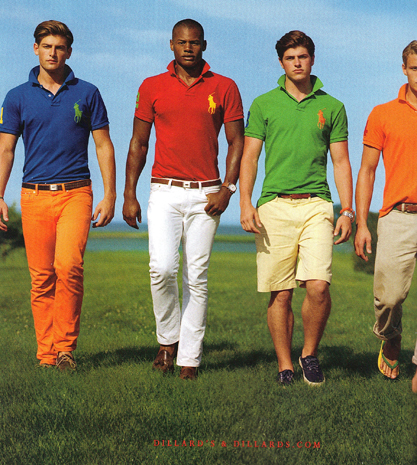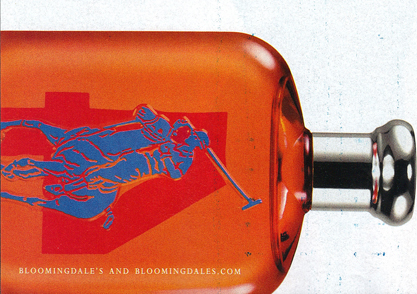| Before discussing the magazines' differences from one another, it is important to point out its similarities. Amidst the various images and articles that differ from one another, three advertisements appear in both Maxim and GQ. The first advertisement is for Ralph Lauren: The Big Pony Collection for Men. Advertisements for deodorants and colognes dot the various pages of both Maxim and GQ. However, throughout the entirety of both magazines, this ad was the only one to appear in each one. Each ad takes up at least two pages (Maxim's takes up 4), and both depict men of different ethnicities either by themselves, with what appears to be fellow polo teammates, or with other girls.
|
 |
  |
While at first, I searched within the images themselves in order to determine who might be interpellated by this ad, I soon came across the specific stores in which the cologne was to be sold at. Maxim's advertisement displays Dillard's & Dillards.com as the sellers of this product. In contrast, GQ displays Bloomingdale's and Bloomingdales.com as the providers of the cologne. This provides a clue as to what impact income level plays in determining masculinity. Obviously the two magazines have two different income levels in mind; Maxim caters to the lower middle and middle income bracket, while GQ caters to the middle and upper middle income bracket. So does income level have an effect on masculinity? From this ad alone, it appears not to. Whether one goes to Dillard's or Bloomingdale's, the cologne remains the same. A study conducted by Donnalyn Pompper revealed there has been a shift away from the thought that being masculine meant being the breadwinner. Income and providing for a family no longer come into the formula for masculinity. The ideology that a man should smell good transcends income level (at least for the middle class), making it possible for any man who smells good to become one step closer to ideal masculinity. |
| The second advertisement that can be found in both magazines is for Camel Crush cigarettes. Unlike the cologne ad, this one does not differ from magazine to magazine. On the left page, the title of the product, followed by the words "own the option" take up most of the page, while the Surgeon General's warning can be found at the bottom. On the right page, the actual cigarette, conveniently dissected so the reader can see what he's getting himself into, takes up most of the page, while actual instructions are placed in the bottom right corner. |
 |
 |
This advertisement is interesting because it is placed within two magazines that governs how the reader views the pages before him, and what ideologies he should buy into. In the midst of being produced and disciplined as subjects by the editors and producers of the magazines (Rose 240), readers are able to "own the option" with this cigarette. With the appearance of agency through the ownership of Camel Crush, readers are once again produced as subjects, this time, as consumers, who should buy this product and buy into the magazines' ideologies. While the ad does not necessarily equate to cigarettes being crucial to the construction of a masculine male, the small amount of cigarette and tobacco ads in relation to alcohol and fragrance ads may suggest while smoking is not foundational to masculinity, it can at least go hand in hand, or at the worst, tolerated through masculinity. |
| The third and final advertisement found in both magazines is for the 2013 Honda Civic. The ad, which claims, "we made the best Civic even better. Introducing a funner, smarter, techier Honda Civic." might say the most about how the magazines visualize masculinity out of the three similar ads. Three key concepts are introduced with this ad: "funner", "smarter", and "techier". With the new Honda Civic offering these three concepts, men who buy into the dominant reading, or those who retain "the institutional/political/ideological order imprinted on [the preferred meaning]" (Rose 133), are placed as subjects who should be funner, smarter, and techier. This ad provides another few requirements for how both magazines visualize masculinity. According to Honda and the editors of Maxim and GQ, being masculine equates to being more fun than the average Joe, being smarter, and being tech-savvy enough to operate a car with a plethora of new features, such as the 2013 Civic. |
  |






